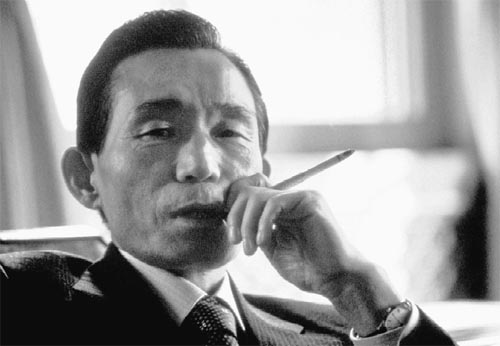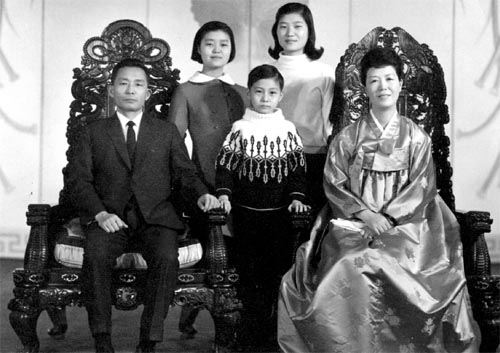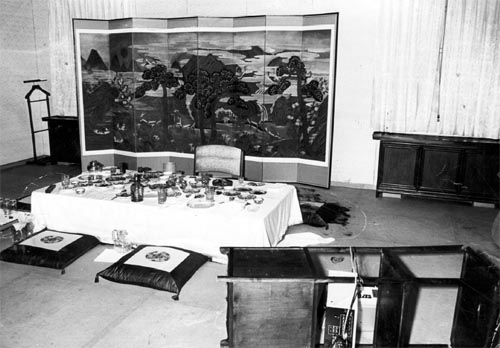A bloody Miracle on the Han: Korea’s rise under Park

President Park Chung Hee in the fall of 1974. An assassin fatally shot his wife three months before this photo was taken. [JoongAng Ilbo]
No modern Korean leader provokes as much passion as Park Chung Hee, the 5-foot-3 general with a stern visage, a taste for fiery liquors and an insatiable hunger for economic statistics.
In his iron-fisted 18-year rule, Park almost single-handedly transformed his country from an abject beggar to an industrial powerhouse. A ruthless military dictator with little patience for democracy, which he considered an inefficient, wasteful luxury on the march to modernization, he ultimately paid for that philosophy with his own life. More than any other Korean leader since independence in 1948, Park gets full credit for launching Korea on the path to economic prosperity.
His violent death 31 years ago today is an occasion to reflect on his very mixed legacy.
The so-called “Miracle on the Han” would never have happened without him. But at what cost to Korea’s political development? Is Korea a model transportable to other impoverished countries? What do Koreans themselves think about Park today?
An August 2009 survey by polling agency Realmeter showed that most Koreans, 53.4 percent of respondents, credit Park among all its leaders for providing the greatest contribution to Korea, well ahead of President Kim Dae-jung (25.4 percent), who won the Nobel Peace Prize in 2000 for his fight for democracy against Park.
The same survey showed that people over 65 were nostalgic for the Park era, while some younger people shudder at the thought of his uncompromising rule.
I had the good fortune to view some aspects of that era closely - too closely, perhaps, for the government’s liking. As a correspondent for The New York Times, reporting daily on street protests and human-rights abuses, I inescapably fell into the group of “antinational” and “effete” individuals whom Park railed against for failing to appreciate his “historic mandate” of modernization.
Park liked to say that his goal was a Korean style democracy - the same kind of intellectual shell game that China’s leaders resort to today. And not unlike the Chinese leaders who sent tanks into Tiananmen Square in 1989, Park’s tragedy was that his rule was stained by too much bloodshed to be universally embraced in his own country. A modernizer he was, yes. But along fascist lines.
I have some vivid personal recollections of Park. In the early morning hours of Oct. 27 1979, a telephone call from Washington woke me up at 3 a.m. with shocking news.
“Jae,” said the voice on the other end of the line. “Get to the office quickly. There’s a coup in Seoul.”
A coup against Park? It seemed out of the realm of possibility. Park’s 18-year regime was designed like an impregnable fortress. He controlled the army, and he had no plausible rivals. If the news was true, could it be a palace coup? A coup de main designed to protect him from civil unrest? A coup to put down all potential challenges to his rule? What would that do to the ongoing pro-democracy movement? What fate was in store for opposition figures like Kim Young-sam and Kim Dae-jung? What would it mean to me personally, caught as I was in the middle of a political crisis triggered by a New York Times interview?
As it turned out, it was not a coup in the normal sense, but something far more dramatic. Park was murdered by his own intelligence chief, Kim Jae-kyu, head of the widely dreaded Korean Central Intelligence Agency, during an argument over dinner on how to respond to a crisis sparked by a Times interview with opposition leader Kim Young-sam. Park and his security chief were dining at a KCIA safe house near the presidential mansion. Park had been dead for more than eight hours when Washington called me. His body, with two fatal bullet wounds, was lying in a hospital morgue just 200 meters (656 feet) from my office.

President Park Chung Hee’s family portrait from the late 1960s. From left is Park, daughter Geun-yeong, son Ji-man, daughter Geun-hye and First Lady Yuk Young-soo.
For weeks preceding the assassination, the country was in a state of heightened tension. Street protests erupted in Busan and Masan, South Gyeongsang, after the ruling party expelled the region’s native son, Kim Young-sam, from the National Assembly. Kim was accused of trying to invite United States intervention to overthrow the Park Chung Hee government. Kim’s expulsion was in reaction to an interview he gave to The Times’ Tokyo bureau chief Henry Scott-Stokes, in which Kim had called on the U.S. to choose between Park’s dictatorship and the forces of democracy.
The two southern cities had been placed under martial law, and at a secret meeting between Kim and the KCIA chief a day before his expulsion from parliament, Kim was warned he would be imprisoned, maybe even killed, if he did not recant and disown his statements to The Times.
I was to be jailed with Kim as his accomplice in the alleged antigovernment plot, a reliable government source later told me. The opposition leader refused, saying he would not take back his words.
By that time, Park’s intolerance to criticism and his propensity for retaliation against any protest, no matter how small, were turning into something his adversaries could use against him.
The number of anti-Park dissidents had dangerously increased to include university students, Christian activists, labor protestors, politicians and journalists. All of them experienced some form of incarceration during this period.
The KCIA chief, wisely, if not consistently, had been counseling moderation in coping with the crisis. But hard-liners like Cha Chi-chol, a fiercely loyal paratrooper commanding the presidential protection force, were in favor of “wiping out [dissidents].” Indeed, Cha is said to have once remarked, “In Cambodia, they don’t hesitate to kill millions.”
In a contest of loyalty, Cha was constantly breathing over Kim’s shoulder. On that fateful evening, Kim went into a rage and shot Cha with a pistol when the latter said army tanks ought to be brought to suppress demonstrators. He then shot Park, in what appeared to have been a premeditated assassination plot. Outside, five of Park’s bodyguards were fatally shot. Before he was hanged for his crime, Kim said his action was meant to end Park’s dictatorship and restore democracy. But was he entirely free from personal ambition? His final testimony left room for doubt for future historians.
Even if Park was thoroughly ruthless politically - having had the Constitution rewritten twice to extend his rule - he was more obsessed with developing the economy.
A leader with a far-reaching vision for industrializing his nation, reinforced by his experience as an officer in the Japanese Imperial Army, Park oversaw the task of economic development with the same intensity he brought to suppressing political opponents. Park drew up five consecutive five-year plans beginning in 1962, and finally normalized relations with Japan in order to get commercial loans and grants from Korea’s former occupier to invest in building basic industries.
Defying suggestions from the World Bank and Japanese donors, Park ordered the construction of Pohang Iron and Steel Company, Korea’s first integrated steel mill. And with Army civil engineers supervising, Park got Hyundai Construction to complete a 428-kilometer (266 miles) expressway linking Seoul and Busan in less than three years. He controlled bank credit so that limited financial resources went only to entrepreneurs willing to undertake difficult projects like shipbuilding and building automobiles. And in order to build up heavy industry, exports became Korea’s strategic growth engine - earning the country hard currency to pay for new industries.

The room in the safe house where Park was assassinated on Oct. 26, 1979. [JoongAng Ilbo]
This model of state-guided development often alarmed institutional lenders like the World Bank, which objected to state intervention in such a wide range of economic activities. The World Bank suggested that instead of a million-ton capacity steel mill, Park ought to build a labor-intensive machinery industry, which would create more jobs.
Park rejected such interference. He decided who should be in what sector of industry, which business group should receive government-guaranteed foreign loans and which sector should receive low-interest policy credits. It was the government all the way, with Park setting the priorities. That was how the controversial and domineering jaebeol (family-controlled conglomerates) came into being. Hyundai was given heavy industry (shipbuilding, automobiles and construction); Samsung took light industry (electronics, textiles, sugar refinery and chemical fertilizer); and Daewoo took textiles and general trading.
‘There was no alternative to dirigisme in a country short on capital and technology,” said Kim Chong-yom, Park’s chief secretary and economic czar at the time.
The seventh child of a peasant family who worked the land, Park was obsessed with eradicating farm-based poverty. It was said that his desperately poor mother, when she discovered she was pregnant with Park, sought in vain to abort him. With that dreadful narrative in his past, Park frequently told associates that such days of national indigence would someday be history. In a room next to his library, he kept a large panel showing progress in every sector of the economy. He kept copious notes, filling them with comments and numbers in the neat handwriting of a former school teacher - Park taught in a primary school before joining the Army.
Notwithstanding his impressive drinking ability, his grasp of statistics - the consumer price index, the very latest export figures and more - was prodigious, striking fear into officials forced to brief him. There were endless meetings with officials in charge of economic management, weekly talks on financial markets, monthly macroindicator sessions, monthly export-promotion meetings and even quarterly project reviews. Cabinet ministers left the office for the golf course at their peril, lest Park be on the line, asking for the latest progress on projects big and small. Not even Chung Ju-yung, the notoriously tough construction magnate of Hyundai Group, felt safe from intrusion. Park would sometimes visit him unannounced, riding in on a helicopter to greet Chung and conduct on-site inspections.
Park showed the same strictness in handling political funds. Politicians from the ruling Democratic Republican Party were forbidden from individually shaking down money from businessmen. The job of collecting a set amount of political contributions was officially given to Park’s secretary Kim Chong-yom, a former Bank of Korea official widely known for being a paragon of integrity.
Park received a certain amount from Kim every month to distribute to the party for operation and elections. Nobody else was allowed to touch money raised for politics, making Park one of the most financially disciplined dictators in history. After his death, officials searching his office found neatly stacked bank notes inside his safe deposit box, with a list detailing how much he gave to whom. He kept none of this money for himself or his family.
That doesn’t mean that Park extirpated the age-old problem of corruption, but it was significantly suppressed while he was in office.
Korea was Park’s personal fiefdom. Park and his chief political partner, Kim Jong-pil, never questioned their ability - or their right - to build the nation. Kim started and ran the KCIA to keep track of adversaries, present and potential, so Park could focus on economic issues. At a news conference shortly after Park’s death, I asked Kim Jong-pil if he ever had misgivings about the May 1961 coup that propelled Park into power for such a long and tumultuous period.
“No, never,” Kim snapped back, looking straight into my eyes. “This country survived on foreign aid when we launched our revolution. Today, we have food, we have roofs over us, we also put private cars on the roads. Our revolution succeeded!”
That shut me up. But somehow, for all that, the glare of economic success seldom outshined the political skullduggery that accompanied Park’s more valiant efforts. Park was unlikely to have played any role in the 1973 KCIA kidnapping of opposition leader Kim Dae-ung in Tokyo, but that ugly incident put a permanent stain on his reputation. So was the stupendous execution in 1975 of eight obscure dissidents on flimsy charges of organizing a pro-North Korean People’s Revolutionary Party. They were hanged just 18 hours after their sentencing. These and other outrages prompted the public to ponder the meaning of Park’s leadership. No amount of economic progress could blanket his excesses. With the hindsight of history, this probably was the best lesson Park left to posterity: that economic miracles are no excuse for political asphyxiation.
*Shim Jae Hoon was the Far Eastern Economic Review’s bureau chief in Seoul, Taipei and Jakarta. He covered the Park Chung Hee years for The New York Times.
By Shim Jae Hoon Contributing writer










with the Korea JoongAng Daily
To write comments, please log in to one of the accounts.
Standards Board Policy (0/250자)